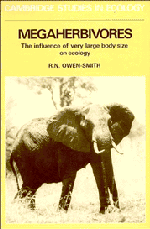Book contents
- Frontmatter
- Contents
- Preface
- 1 Prologue
- 2 Morphology, evolutionary history and recent distribution
- 3 Food and other habitat resources
- 4 Space–time patterns of habitat use
- 5 Body size and nutritional physiology
- 6 Body size and feeding ecology
- 7 Social organization and behavior
- 8 Life history
- 9 Body size and sociobiology
- 10 Body size and reproductive patterns
- 11 Demography
- 12 Community interactions
- 13 Body size and population regulation
- 14 Body size and ecosystem processes
- 15 Late Pleistocene extinctions
- 16 Conservation
- 17 Epilogue: the megaherbivore syndrome
- Appendixes
- References
- Index
17 - Epilogue: the megaherbivore syndrome
Published online by Cambridge University Press: 01 June 2011
- Frontmatter
- Contents
- Preface
- 1 Prologue
- 2 Morphology, evolutionary history and recent distribution
- 3 Food and other habitat resources
- 4 Space–time patterns of habitat use
- 5 Body size and nutritional physiology
- 6 Body size and feeding ecology
- 7 Social organization and behavior
- 8 Life history
- 9 Body size and sociobiology
- 10 Body size and reproductive patterns
- 11 Demography
- 12 Community interactions
- 13 Body size and population regulation
- 14 Body size and ecosystem processes
- 15 Late Pleistocene extinctions
- 16 Conservation
- 17 Epilogue: the megaherbivore syndrome
- Appendixes
- References
- Index
Summary
In the preceding chapters of this book I have documented a variety of aspects of the ecology of those large mammalian herbivores that exceed 1000 kg in adult body mass. I have analyzed how these ecological features are related to the allometric trends evident among smaller species of large herbivore. I have pointed out a number of phenomena that appear to be characteristic of these so-called megaherbivores. I now want to draw together these threads to assess the degree to which megaherbivores share in common a distinct set of coadapted features, which can be referred to as the megaherbivore syndrome.
Faunal patterns
Only in parts of Africa and tropical Asia are the faunal communities of today representative of those that prevailed during the Pleistocene and earlier times in the geological record. In Africa the five extant species of megaherbivore make up only a small fraction of the total species diversity of large (> 5 kg) herbivores present continent-wide. The distribution of some 79 herbivore species in different ranges of body size suggests the existence of three modes in species richness: (1) at a body size of about 100–200 kg, made up largely of ruminant artiodactyls occupying savanna habitats; (2) at a body size of about 20 kg, consisting predominantly of forest duikers; (3) a small outlying blip in the megaherbivore size range, with most of these species being non-ruminants (Fig. 17.1).
- Type
- Chapter
- Information
- MegaherbivoresThe Influence of Very Large Body Size on Ecology, pp. 309 - 316Publisher: Cambridge University PressPrint publication year: 1988



